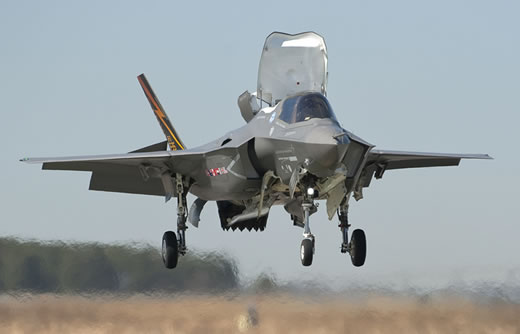Media sources are reporting that the United Kingdom might possibly be revisiting its previous decision to abandon the use of carrier-based STOVL aircraft. The United Kingdom’s opposition Labour Party reportedly delivered a letter to the Ministry of Defence questioning the governing Conservative Party’s ongoing defense review that supposedly may result in a reinstatement of budgetary request authority to procure the F-35B STOVL variant of the Joint Strike Fighter as part of the FY2012/13 budget request.
In the 2010 Strategic Defence and Security Review (SDSR), the Ministry of Defence announced its decision to abandon the F-35B STOVL in favor of the conventional carrier-launched F-35C variant for deployment as early as 2020. The SDSR stated that the F-35C variant was better suited to meet the needs of the Royal Air Force and Royal Navy and would prove to be a better economic fit than the F-35B STOVL variant. At the time the SDSR was being finalized, the F-35B was at serious risk of being cancelled. That threat has since been eliminated.
Speculation has been rife for many weeks regarding the possibility of high-level discussions being conducted between the US Department of Defense and the United Kingdom concerning the F-35 variant to be acquired for carrier operations.
Labour Party concerns appear to revolve around the rising costs and difficulties recently associated with the F-35 program and additional costs necessitated by a redesign of the new Queen Elizabeth-class carriers. The governing Conservative Party has admitted publicly that all aspects of the FY2012/13 budget submission are under review and a decision would be delivered to Parliament this spring.
The UK’s Future Force 2020 military reorganization blueprint includes a decision to reestablish a carrier-strike force as part of the Royal Navy’s modernization project. A reversal of the government’s decision not to deploy the F-35B STOVL variant would have a significant impact on the construction of the Queen Elizabeth-class aircraft carriers. A government study reviewing plans to redesign the new carrier force is examining the costs related to changing the designs to accommodate conventional-takeoff aircraft instead of STOVL-capable aircraft with a detailed report expected to be published later this year.
The first Queen Elizabeth-class carrier, now under construction, would require removal of the STOVL ramp if the F-35C does in fact become the aircraft variant of choice. The cost of this work is estimated to be at least $1.9 billion, an amount that could eventually be a critical factor in deciding the variant to be purchased. This first carrier, when delivered in 2016, may actually be mothballed or be sold. The second carrier is expected to be delivered sometime in 2018 and would not be placed into operation until 2020 with a projected aviation element consisting of only six aircraft.
The 2010 SDSR outlined the need to fit at least one of the new carriers with arresting gear and catapults to accommodate the F-35C variant should the F-35B STOVL variant be abandoned. The redesigned carrier is planned to be equipped with Atomics’ electromagnetic launch system, a concept that would further enhance the Royal Navy’s ability to more completely meet interoperability requirements when conducting joint operations with the United States and France.
It does appear likely that a return to the F-35B may be more of a response to the burgeoning costs of the redesign, maintenance, and operation of the aircraft carrier itself. The UK’s final decision on which variant to buy may be predicated on a reevaluation of fiscal reality and the cost of redesigning the Queen-Elizabeth-class carrier.

















